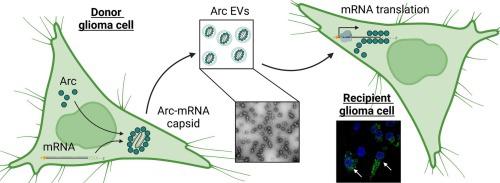Biochimica et Biophysica Acta (BBA) - General Subjects ( IF 3 ) Pub Date : 2023-11-22 , DOI: 10.1016/j.bbagen.2023.130522 Aya Al Othman 1 , Dmitry Bagrov 2 , Julian M Rozenberg 1 , Olga Glazova 1 , Gleb Skryabin 3 , Elena Tchevkina 3 , Alexandre Mezentsev 1 , Mikhail Durymanov 4

|
Background
Activity-regulated cytoskeleton-associated (Arc) protein is predominantly expressed in excitatory glutamatergic neurons of vertebrates, where it plays a pivotal role in regulation of synaptic plasticity. Arc protein forms capsid-like particles, which can encapsulate and transfer mRNA in extracellular vesicles (EVs) between hippocampal neurons. Once glioma cell networks actively interact with neurons via paracrine signaling and formation of neurogliomal glutamatergic synapses, we predicted the involvement of Arc in a process of EV-mediated mRNA transfer between glioma cells.
Materials and methods
Arc expression in three human glioma cell lines was evaluated by WB and immunocytochemistry. The properties of Arc protein/mRNA-containing EVs produced by glioma cells were analyzed by RT-PCR, TEM, and WB. Flow cytometry, RT-PCR, and fluorescent microscopy were used to show the involvement of Arc in EV-mediated mRNA transfer between glioma cells.
Results
It was found that human glioma cells can produce EVs containing Arc/Arg3.1 protein and Arc mRNA (or “Arc EVs”). Arc EVs from U87 glioma cells internalize and deliver Arc mRNA to recipient U87 cells, where it is translated into a protein. Arc overexpression significantly increases EV production, alters EV morphology, and enhances intercellular transfer of highly expressed mRNA in glioma cell culture.
Conclusion
These findings indicate involvement of Arc EVs into mRNA transfer between glioma cells that could contribute to tumor progression and affect synaptic plasticity in cancer patients.
中文翻译:

逆转录病毒样gag蛋白Arc/Arg3.1参与细胞外囊泡介导的神经胶质瘤细胞之间的mRNA转移
背景
活性调节细胞骨架相关(Arc)蛋白主要在脊椎动物的兴奋性谷氨酸能神经元中表达,在突触可塑性的调节中发挥着关键作用。Arc蛋白形成衣壳样颗粒,可以封装并在海马神经元之间的细胞外囊泡(EV)中转移mRNA。一旦神经胶质瘤细胞网络通过旁分泌信号传导和神经胶质细胞谷氨酸突触的形成与神经元积极相互作用,我们预测 Arc 参与 EV 介导的神经胶质瘤细胞之间的 mRNA 转移过程。
材料和方法
通过WB和免疫细胞化学评估了三种人神经胶质瘤细胞系中的Arc表达。通过 RT-PCR、TEM 和 WB 分析了神经胶质瘤细胞产生的包含 Arc 蛋白/mRNA 的 EV 的特性。流式细胞术、RT-PCR 和荧光显微镜用于显示 Arc 参与 EV 介导的神经胶质瘤细胞之间的 mRNA 转移。
结果
研究发现,人胶质瘤细胞可以产生含有 Arc/Arg3.1 蛋白和Arc mRNA 的 EV(或“Arc EV”)。来自 U87 神经胶质瘤细胞的 Arc EV 内化Arc mRNA并将其递送至受体 U87 细胞,并在其中翻译成蛋白质。Arc 过表达显着增加 EV 产量,改变 EV 形态,并增强神经胶质瘤细胞培养物中高表达 mRNA 的细胞间转移。
结论
这些发现表明 Arc EV 参与神经胶质瘤细胞之间的 mRNA 转移,这可能有助于肿瘤进展并影响癌症患者的突触可塑性。



























 京公网安备 11010802027423号
京公网安备 11010802027423号